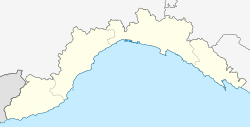Seborga A Seborca/A Seburca | |
|---|---|
| Comune di Seborga | |
 Seborga | |
| Coordinates: 43°49′34″N7°41′40″E / 43.82611°N 7.69444°E | |
| Country | Italy |
| Region | Liguria |
| Province | Imperia (IM) |
| Government | |
| • Mayor | Enrico Ilariuzzi |
| Area | |
• Total | 4.91 km2 (1.90 sq mi) |
| Elevation | 500 m (1,600 ft) |
| Population (31 December 2015) [2] | |
• Total | 315 |
| • Density | 64/km2 (170/sq mi) |
| Demonym | Seborghini |
| Time zone | UTC+1 (CET) |
| • Summer (DST) | UTC+2 (CEST) |
| Postal code | 18012 |
| Dialing code | 0184 |
| ISTAT code | 008057 |
| Patron saint | San Bernardo |
| Saint day | 20 August |
| Website | Official website |
Seborga (Ligurian : A Seborca/A Seburca) [3] is a small village and self-proclaimed principality in the region of Liguria near the French border. Administratively, it is a comune of the Italian province of Imperia. The main economic activities are horticulture and tourism. It is known for being the 'territory' of the self-proclaimed micronation the Principality of Seborga. It is one of I Borghi più belli d'Italia ("The most beautiful villages of Italy"). [4]





